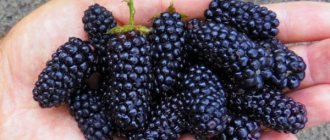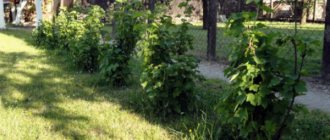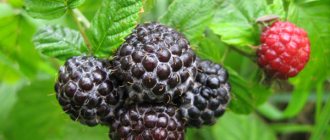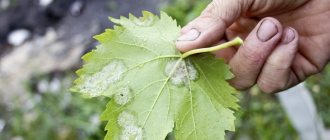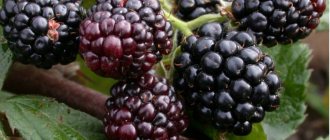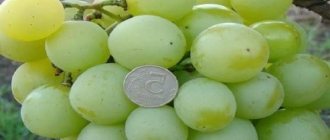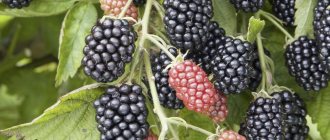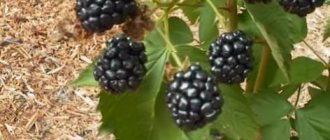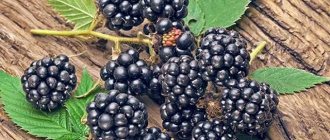Black raspberries and blackberries have ceased to be exotic in home gardens and garden plots. Such berry crops are successfully grown not only by experienced gardeners, but also by novice summer residents. Aronia raspberries and blackberries perfectly combine excellent taste, as well as a very attractive and marketable appearance of the berries.
Raspberry-blackberry hybrids have also become very popular in our country, the cultivation of which is also not too burdensome. Breeders have obtained varieties of blackberries, black raspberries and blueberries suitable for cultivation in regions with unfavorable soil and climatic conditions.
Characteristics and differences
Aronia raspberries are certainly different from blackberries, and have the following characteristic features::
- The main difference between blackberries is that the receptacle breaks off at the site of attachment to the stem, as a result of which it remains inside the ripe berry;
- blackberries have a smooth and flat edge of the stem part, and a ripe berry has a white core;
- black-fruited raspberries, in contrast to red-fruited varieties, are characterized by a more rounded or hemispherical shape and small receptacle size;
- Chokeberry shoots are shorter than red raspberries and they are located closer to the ground;
- blackberry shoots grow quite tall and powerful, reaching a height of 3 m or more;
- Blackberry shoots are green in color and have strong and very strong thorns.
Blackberry-like blackberries have become increasingly common in gardens and home gardens in recent years, and their cultivation is not too different from the cultivation of classic varieties.
Red and black raspberries ripen in July, but the timing of harvest may vary depending on weather conditions in the region of cultivation. Blackberries, even very early varieties, ripen somewhat later than raspberries. It is for this reason that it is recommended to plant mid-late and late varieties only in the southern regions, where the berries have time to ripen before the onset of the cold autumn period.
Planting and growing
Black raspberries do not differ from red-fruited varieties in most planting and care parameters. It also loves areas of the garden with diffused sunlight, fertile, loose and moisture-absorbing soil, and abundant watering. But there are also features, knowledge of which will allow you to obtain a bountiful and high-quality harvest.
Landing
Black raspberries are planted both in spring and autumn. A trench is prepared with a depth of 40–50 cm. Fresh organic matter is placed at the bottom - this is food in reserve, on top of humus or compost in half with garden soil. A distance of 50–70 cm is maintained between plants in a row, row spacing is left wide, up to 2 m, after planting they are mulched with straw, fallen leaves, and old sawdust.
An effective way to grow this type of raspberry is on a trellis (How to make a trellis with your own hands, read the article https://happy-villa.ru/shpalera-dlya-maliny.html). This allows the gardener to regulate reproduction. If young shoots are not needed, the lashes are lifted from the ground and tied to a trellis, thus preventing the rooting of the tops.
Bush formation
Since Cumberland is a vigorous plant, it is advisable to form a bush. Double pruning produces a good effect. In young growth (shoots of the first year of growing season), as soon as it reaches a size of 50–60 cm, the top is cut off. This stimulates the appearance of lateral branches from the axillary buds; by the end of summer they reach a meter in length.
The second pruning is carried out in early spring, leaving up to 6 living buds on each branch - this is the basis of the future harvest. The result is a highly branched bush with an abundance of flowering and then fruiting clusters.
Advice! The plant is responsive to shaping; this property is used in landscape design, sending powerful lashes along the lattice of a hedge, creating arches, and planting near a gazebo.
Black Cumberland raspberries love fertilizing both during planting and during care - in this case the fruits turn out sweeter and larger. Twice a season - after flowering and the first mass harvest, prepare a nutritious cocktail for the berry plant. Dilute mullein in a ratio of 1:10 or chicken manure (1:20), add a tablespoon of complex fertilizer, such as Kemira, to a bucket of the mixture, and distribute a liter under each bush. Do not forget about the rule - feed after abundant watering!
Cumberland and Ezhmalina are more demanding of moisture than red-fruited varieties. With a lack of watering, the berry turns out dense and dry. To retain moisture, the surface of the raspberry tree is mulched with a layer of at least 5–7 cm; this is also a good organic fertilizer for the next year.
Black raspberries are a frost-resistant plant, but to be safe for the winter, it is better to remove the branches from the trellis and bend them to the ground. This will retain the snow and protect the roots and stems from freezing.
Black raspberry "Cumberland": characteristics of the variety (video)
Ripe berries are elongated, with an average weight of more than 5 g. The ripe pulp is sweet and sour, with a pronounced blackberry aftertaste, black in color. Fruiting is stable, annual, occurs at the end of August and lasts until the onset of serious frosts. The yield indicators are very high and, under conditions of high agricultural technology, amount to about 9.5-10.5 kg of berries from each bush. The hybrid is characterized by insufficient winter hardiness, but is distinguished by drought resistance and abundant fruiting.
No less popular is the hybrid form called “Loganberry”, which has excellent quality characteristics. The hybrid is distinguished by the absence of thorny shoots and produces large and very tasty berries. The bushes are of a spreading type, no more than two meters high, without the formation of root shoots.
Fruiting continues from mid-August until the onset of frost. The average weight of a marketable berry is 9.5-10.5 g, and the overall yield indicators reach 9.5-10.5 kg per plant. Reproduction of this hybrid form is possible by planting and rooting annual shoots, as well as by cuttings. Caring for berry crops is standard and not too difficult even for novice gardeners.
Features of reproduction
The main distinguishing feature of black raspberry varieties is the method of propagation. Since the plant does not produce shoots, two options for obtaining planting material are used - rooting the tips of the growth and layering.
Reproduction by rooting tops
After fruiting comes to an end, and this is somewhere in mid-August, the lashes will begin to “gravitate” towards the ground, trying to cling to the soil. To obtain seedlings with a good root system, the tops are pinned to the soil and lightly sprinkled with soil. After 1.5 months, completely viable roots will form at the point of contact with the soil, and the black raspberry seedling can be transplanted to a permanent place in the fall. If the root system is weak, it is better to leave the plant until spring.
Advice! After the seedling has taken root, it is separated from the mother shoot by cutting the stem at a distance of 20–25 cm. It is left in place for some time to grow roots, then it is replanted.
Reproduction by layering
Some gardeners specifically grow cuttings. In mid-summer, some of the branches are taken away from the bush, pressed to the ground and not the top, but the middle of the stem is buried. In this case, 2 full-fledged seedlings are obtained from one branch.
Due to their external similarity, people often confuse blackberries and black raspberries. These two cultures are not widespread, so there is little experience to recognize them.
But there are distinctive features, having studied which, it becomes impossible to mistake one for the other. Let's look at how blackberries differ from black raspberries.
Popular varieties
Currently, gardeners are growing several quite promising and very productive varieties of black raspberries. Despite the fact that they belong to the heat-loving category, many varieties are perfectly adapted for growing in the soil and climatic conditions of central Russia.
| Variety name | Botanical description | Characteristics of the berry | Varietal features |
| "Gift of Siberia" | Powerful and tall, spreading bushes, do not form shoots. | Small and medium size, weighing 1.6-2 g, dense, dessert taste | Winter-hardy, highly resistant to diseases and pests. Productivity is about 3.9-4.5 kg per bush |
| "Turn" | The bushes are powerful and tall, do not form overgrowth | Medium size, weighing 1.6-1.8 g, dense and transportable | Short fruiting period. Productivity up to 5.4 kg per bush |
| "Ember" | Bushes of medium vigor, medium spreading | Berries with an average weight of 1.75-1.85 g, black, dense | Winter hardiness is satisfactory, resistance to diseases and pests is high |
| "Luck" | Medium spreading bushes with few thorns | Marketable berries, weighing up to 1.7-1.8 g | Productivity up to 6 kg. Propagated by horizontal layering, cuttings or seed |
| "Litach" | The bushes are vigorous, the shoots are hard, bent, with large thorns | The berries are medium or small, close to spherical in shape | An early ripening variety that bears fruit on two-year-old shoots |
| "New Logan" | Powerful bushes, up to 2-2.2 m high | The berries are medium-sized, black with a pronounced gloss | Early berry ripening. Needs shelter for the winter |
| "Bristol" | Bushes of medium vigor, heavily thorned | The berries are large, with sweet pulp | Very productive variety |
| "Earlie Cumberland" | The bushes are powerful and tall, do not form overgrowth | Berries weighing up to 2-2.2 g, round shape, black-violet color, sweet taste, very dense consistency | The total yield does not exceed 2-2.5 kg per bush. Shelter required for winter |
Differences in care
These plants, being relatives and having common diseases, cannot coexist and inherit the site from each other. The proximity of nightshades: eggplants, tomatoes, potatoes, and other varieties of raspberries is also extremely undesirable.
Drought resistance
Both plants tolerate drought quite well, but during the fruiting period it is advisable to water them additionally to improve the quality of the berries. Both do not like stagnant water, but they are favorable to watering.
At the same time, blackberries are more resistant to drought, as well as pests and diseases, while raspberries wither when there is a lack of moisture.
Heat Requirements
Blackberries do not tolerate shading, reacting extremely negatively to it. For this crop, the warmest and sunny places are desirable, while raspberries calmly tolerate light shade.
Soil requirements
Both crops are not suitable for stagnant water in the soil; they like drained soil that retains heat and is supplied with minerals.
- The best blackberry harvest is obtained when it grows on fertilized, well-drained loam that has a neutral or slightly acidic reaction. Limestone soil is not suitable for it - a lack of iron and magnesium can affect the health of the plant, and it can be affected by chlorosis.
- Black raspberries like loamy and sandy loam soil, preferably if it is well fertilized. The maximum yield will be obtained if the bush is planted in light loamy black soil or gray forest soil.
Frost resistance
The blackberry bush needs more warmth than the raspberry bush. So, it is recommended to cover it for the winter to protect the root system and stems from freezing, especially if the winter is snowless and frosty. Temperatures of -15°C are detrimental to shrubs. Raspberries are immune to cold, withstanding -20-25°C, but if winters in the growing region are cold, it would be better to cover them to avoid freezing.
Read also: What does the porcini mushroom look like?
Productivity
The compared crops are characterized by high yields, but blackberries are still much more prolific: depending on the variety, they can produce up to 20 kilograms of berries per season, while the raspberry bush can produce up to 4 kilograms of berries.
Garden neighborhood
Many novice gardeners wonder whether it is possible to plant raspberries next to blackberries or garden blueberries, and are also interested in how such a neighborhood can affect the productivity and yield indicators of berry crops.
According to the observations of specialists and experienced gardeners, black raspberries and blackberries do not form offspring, but form exclusively replacement shoots, therefore they get along well in one area in close proximity to each other. Thus, it is as easy as possible to control the process of propagation of bushes and care for berry crops.
There are quite conflicting opinions regarding the proximity to blueberries. It is recommended to install special limiters in the ground. To grow blueberries, you need to make a planting hole with acidic soil. If there are restrictions, it is possible to plant raspberries and blackberries nearby in soil with optimal acidity levels. It should be remembered that blueberries do not respond well to the shading that tall blackberries and raspberries can create.
Not only tasty, but also healing
Black raspberries are not only tasty, but also have pronounced beneficial properties. The berries contain a full complex of vitamins (A, C, PP, group B), a lot of potassium, iodine, copper, due to which they have a restorative, anti-inflammatory, and tonic effect on the body.
But the main advantage of the plant is its high amount of antioxidants - carotene and ascorbic acid. By neutralizing free radicals, these powerful biologically active compounds prevent oxidative processes that destroy our body at the cellular level. Consumption of foods containing antioxidants is the best way to prevent cell mutation and their degeneration into malignant formations.
Read also: Lenara cucumber f1 reviews
Ezhemalina - who is she and why is all this?
Hybridization of raspberries and blackberries began in the USA at the beginning of the last century. Already the first result (the Loganberry variety) demonstrated the prospects for obtaining hybrid varieties. Hybrid plants are distinguished by incomparable yield and large-fruitedness compared to raspberries, do not “crawl” throughout the entire area and have a rich taste and aroma.
Blackberries are included in hybridization with raspberries not only to obtain raspberry-blackberry hybrids (actually, blackberries), but also to improve the characteristics of raspberries. Many large-fruited varieties of modern raspberries carry blackberry genes, since raspberries voluntarily do not want to grow larger and increase the number of fruits. So it will soon be difficult to draw a clear line: these are raspberries, and these are hybrids with blackberries.
By the way, a side effect of large-fruited and productive raspberry varieties that carry blackberry genes is lower frost resistance.
Accordingly, even in blackberry trees, which carry significantly more blackberry characteristics, frost resistance is rather weak; without shelter in most regions one cannot count on a normal harvest. But we are no strangers! In Siberia, apple trees are also covered.
Sellers in advertising descriptions note that crossing blackberries with raspberries increased winter hardiness. At the same time, they modestly keep silent about what “increased the winter hardiness” of blackberries growing in California. For Russia, this means uncovered cultivation in the Rostov region and further south, and even then with possible damage to the shoots in harsh winters.
Somehow the name of the ezhmalins still hasn’t worked out: they are called blackberry-like raspberries (Michurinsky red-fruited “Texas”), raspberry-like blackberries, raspberry-blackberry and blackberry-raspberry hybrids, as well as derivatives of varietal names - loganberry, boysenberry, etc. The name “ezhemalina” in this article was chosen primarily for brevity. Well, as a reflection of the essence of the result, many hybrids have more blackberry characteristics than raspberry ones: powerful stems, absence of root shoots, productivity, large flowers and berries attached to the fruit. Raspberries gave a slight increase in winter hardiness, less “thorniness”, the taste and aroma of the berries were enriched, and sourness was added.
The presence of raspberry genes also slightly reduced the lighting requirements - blackberries are noticeably more light-loving. And yet, varieties will be able to fully reveal their potential only in regions with sunny summers.
Ezhmalina is grown quite successfully in a cover crop in Altai, and this is the 2nd winter hardiness zone. But there is usually a lot of sun in summer. Residents of regions with a continental climate should pay special attention to every malin.
However, there are varieties that perform quite well in the middle zone.
Raspberries and blackberries benefits. Currants
Advantages of red currant leaves:
- elimination of vitamin deficiency;
- increasing the protective properties of the body;
- preventing the development of cancer and slowing tumor growth;
- actively used to treat cystitis;
- anti-cold action.
Blackcurrant can produce the following effect:
- stimulation of adrenal gland growth, treatment of Addison's disease;
- stimulation of immunity;
- fight against vitamin deficiency;
- preventing the appearance of tumors;
- treatment of gastritis with low acidity;
- treatment of dermatitis and eye diseases.
Thus, we are convinced that blackberry leaves are a treasure trove of beneficial properties, vitamins and minerals.
The wide range of uses indicates their recognized healing qualities and the possibility of their use to improve health and prevent disease. Blackberry (Rubus caesius).
Other names: ozhin, deaf raspberry, dereza.
Description. Subshrub of the Rosaceae family, with ascending or lying, often arched shoots with a bluish or white coating on the leaves, 50 - 150 cm high. Shoots with thin curved spines of two types: annual non-lignified vegetative and biennial woody. Biennial shoots bear fruit and then die. The leaves are alternate, divided into three lobes, with lanceolate stipules and petioles covered with spines, with jagged edges, light green, pubescent on both sides. The lateral leaves are sessile, the apical ones are on petioles covered with spines or pubescent. The flowers are relatively large (up to 2 cm in diameter), with pubescent green cups and white petals, collected at the end of the stem in sparse corymbose racemes. Flowers appear unfriendly. Pedicel with glands, calyx covered with thin gray felt. The ovaries are bare. The fruits in appearance resemble raspberries, but do not have such a pleasant aroma and are not separated from the stalks, consist of a small number of drupes with large flattened seeds, black, dull, large, with a bluish bloom, fleshy, juicy, sweet. Blooms from May to August. Fruits in August - September. Propagated vegetatively (cuttings, layering, suckers) and seeds. It grows in forest clearings, along river banks, in water meadows, near road ditches, near swamps, in damp forests. Forms dense thickets in well-lit areas. Gray blackberries are common in Europe, Asia, and North America.
